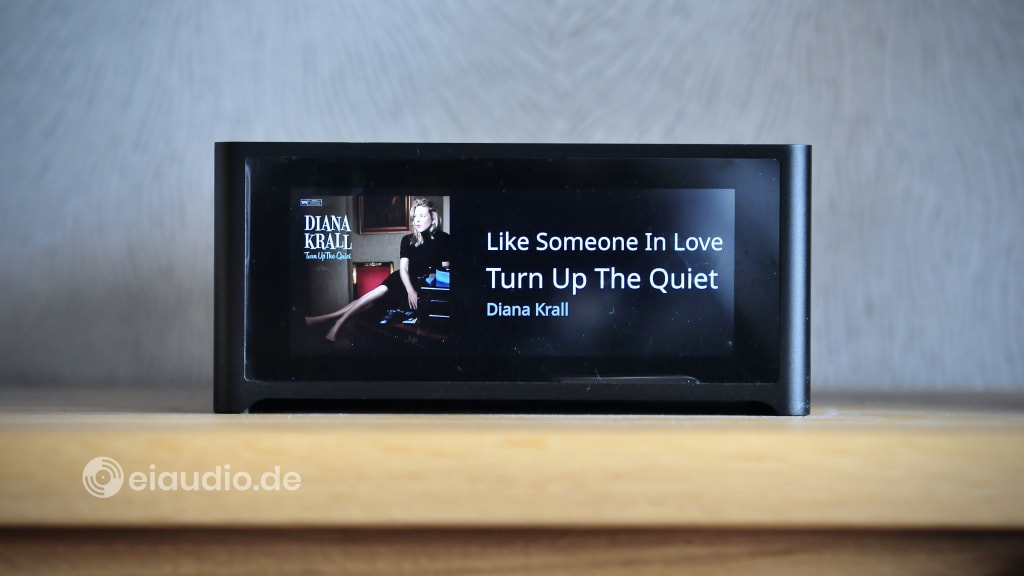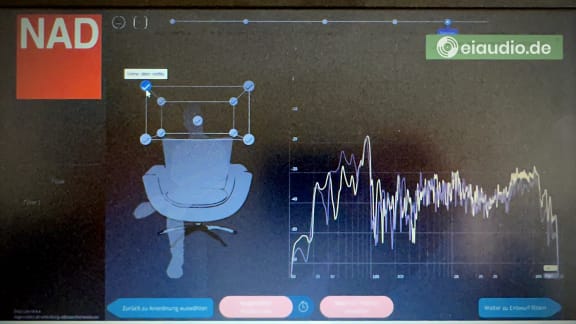NAD M-10 Streaming Amplifier
Published: 10/12/2022
Manufacturing date: 2019
Author: Karsten Hein
Category: Gear & Review
Tag(s): Receivers
When I think about audiophile listening pleasures, my first association is a meticulously set up stereo system, including at least one tube stage, with its loudspeakers carefully placed in a dedicated listening room. I imagine the listening position to form an equilateral triangle with the speakers and a high-floor carpet to counterbalance a high ceiling. I see myself in this position alone and understand that absolute soundstage and tonality perfection can only be enjoyed by one listener at a time. And while this could be seen as a selfish vision, I can assure you that in most households, there is only one single person who cares about the subject and is willing to set up a HiFi system in this way. Audiophiles are a rare species, and achieving proper sound balance takes years of experience.
When I first met our next door neighbour Alexi, I was therefore surprised to learn that he had purchased some HiFi components that had been specifically designed to break these rules. His Duevel Planets loudspeakers, for instance, were of an omni-directional design using two metal spheres to radiate the sound full-circle into the room. This concept allowed listeners to receive a fully realistic stage impression from various listening positions in the room. My review of these speakers recognised the benefit of the Duevel Planets in the ability to share the music experience with more than one listener at a time. Because, even if the other family member did not care so much about sound stage and tonality, the ability for them to share in the experience was still an improvement.
The other component to challenge established audiophile rules was Alexi’s DAD M-10 music streaming-amplifier. First released in 2019, the compact NAD claimed to offer 100 watts per channel of continuous music output into an 8 Ohms load. Weighing around 2.5 kilos, it was equipped with a large LCD display that covered the whole front of the unit. Alexi had not yet pealed off the protective film, a measure that slightly showed on the photos. There were no visible buttons or lights, except for the illuminated NAD logo on top of the unit that signalled operation. It could not have been a sleeker and less pretentious looking device. And coming from large and heavy separate vintage components myself, I was not sure what was to be expected from such a design.
Upon my first visits to Alexi’s house, the combination of M-10 streamer-amplifier and Duevel speakers had sounded rather frail and disorganised. When I later tested the Duevels in our listening room and on our system, this frailness was gone. I felt that the NAD amplifier might be the culprit and gave Alexi our Tannoy XT 8f speakers to test. Different from the Duevels, the Tannoys sounded bass heavy and overly boomy in Alexi’s house. Looking at the listening room, and following my explorations on the subject of room modes, I understood the room dimensions to be responsible for the repeated unbalances sound. In marked contrast to our one hundred year old building with high ceilings and masonry walls, modern buildings had much lower ceilings and open plan kitchen & living room layouts with lots of hard concrete being used.
Low ceilings in spacious rooms that are paired with concrete walls make setting up proper stereo systems almost impossible, because they excite an unbecoming combination of high and low frequency room modes, creating a discordant boxy impression. We can probably all relate to this sound when we imagine speaking or clapping in an underground carpark or in the pedestrian tunnel leading underneath railroad tracks. In addition to these attributes, the necessary furniture in the room also did not allow us to freely set up the Duevels or Tannoys in their ideal positions. Without knowing it, Alexi and I had found the perfect room to explore the full potential of the NAD M-10 that came with Dirac live room correction. We decided to be serious about getting it right and made a proper appointment for the purpose of setting up his system.
On the day of our exploration, I packed my best Manfrotto tripod that would allow us to set the microphone up in the exact positions that were prescribed by the calibration software. I had meanwhile read that Dirac had started as a research project at the Signals & Systems group at Uppsala University of Sweden during the 1990s. The project objective had been to revolutionise the world of sound through digital signal processing. The researchers found that all components of a sound system contributed to a degradation of sound and that the listening room was one such component. The algorithms developed by the team had finally lead to the founding of the Dirac audio company in 2001. Dirac room correction technology can today be found in audio gear from well-known names in the industry: Arcam, Dynaudio, Emotive, Focal, Integra, JBL & Lexicon Harman, Marantz, Monoprice, NAD, Onkyo, Pioneer, Quadral, Hotel, and others.
Alexi downloaded the Dirac software to his laptop computer, and we proceeded to set up the tripod and microphone in his preferred listening position on the sofa. We started the analysis with Dirac running a few frequency sweeps. The resulting graph showed the low frequency hump at 80-90 Hz. It also showed the rest of the bass frequencies to respond unevenly, with a dip at 40 Hz and a peak at 50 Hz. A slight hump between 6-10 kHz was followed by a sharp drop from 12 kHz onwards. Our first measurements were followed by eight adjacent microphone positions that formed a three-dimensional cage around the central listening position by moving the microphone 50cm diagonally in each direction. Dirac ran a number of sweeps in each position. The Manfrotto tripod allowed us to meet each required position exactly.
Once all nine positions had been measured, Dirac suggested the optimal digital adjustment to the curve from 19 Hz to 500 Hz. The NAD M-10 could also have run the calculation for the higher frequency spectrum, however, Dirac would have required us to pay 100 EUR extra for this service. Since the Tannoys had most obviously been suffering from a boomy bass, we decided that we would first give the bass correction a listen. Alexi transferred the new curve to the M-10 and we listened to some of the same songs that we had listened to before the correction. The improvement was immediately audible. The boomy bass had given way to a well-defined, controlled, and refined bass. As a consequence, Diana Krall’s voice was louder, clearer, and tonally more accurate than before. What was left was the sensation that some significant high frequencies were missing from the music. This had the effect that the aura around instruments was missing with the music sounding slightly stale and lifeless.
Satisfied with the result, I think we both would have liked to experience the correction of the upper frequencies as well, however, we decided to leave this for a later day. Even with just the bass frequency adjustment, the NAD M-10 had been able to show the benefit of room correction in circumstances that prohibited the ideal placement of loudspeakers. I could appreciate the positive effect on bass and voice performance and for the first time would have liked to stay and listen for longer. There were some genuine qualities to the music that had been missing before. I enjoyed the deeper and tighter bass that was free of unwelcome resonances throughout the listening room.
Room correction algorithms proved to be immensely useful wherever the room and the loudspeakers were in unfavorable relation to each other. And this did happen more often than one might think, especially in private households and rooms of mixed use. The NAD M-10 and Dirac offered a, not exactly cheap but very effective, method to harmonise the HiFi system with the listening room. In this respect, the two manufacturers NAD and Dirac together offered some real-world listening comfort to many people who would otherwise have had to settle for a rather mediocre result.
Specifications
AMPLIFIER
- Continuous power output: 100W (4-8 Ohms)
- Frequency response: 20 - 20,000 Hz (±0.6 dB)
- Total harmonic distortion: <0.03 % (20 Hz – 20 kHz)
- Signal-to-noise ratio: >90 dB
- Clipping (8/4 Ohms): 130/230 W (@ 1 kHz, 0.1 % THD)
- Dynamic power (8/4 Ohms): 160/300 W
- Damping factor (8 Ohms): >190
- Treble adjustment: ±6.0 dB @ 20 kHz
- Bass adjustment: ±6.0dB @ 60 Hz
- Channel separation >75 dB (1 kHz)
- Input sensitivity line: 1.0 V
- Digital input: -6.2 %FS
- Standby power: 0.5W
DAC
- Audio formats: MP3, AAC, WMA, OGG, WMA-L, ALAC, OPUS
- High-resolution audio: MQA, DSD, FLAC, WAV, AIFF
- Sampling rate: 32 bit/192 kHz PCM max.
- Bit depths: 16 – 24
BLU-OS
- Supported operating systems: Microsoft Windows XP, 2000, Vista, 7, 8 to current Windows Operating Systems, and macOS versions
- Mobile operating system (BluOS): Free Android and iOS App
- Supported cloud services: Spotify, Amazon Music, TIDAL, Deezer, Qobuz, HDTracks, HighResAudio, Murfie, JUKE, Napster, Slacker Radio, KKBox, Bugs
- Free internet radio: TuneIn Radio, iHeartRadio, Calm Radio, Radio Paradise
- Bluetooth standard: Bluetooth aptX HD (built-in)
- Bluetooth connectivity: bi-directional, receive and headphone
- Network connectivity: Gigabit Ethernet RJ45, 802.11 b/g/n WiFi
PHYSICAL
- Dimensions: (W)215 mm (H)100 mm x (D)260 mm
- Unit weight: 2.5 kg
- Country of manufacture: N.N.
- Year(s): 2019-2020





